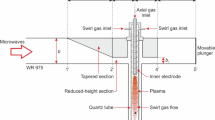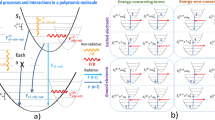Abstract
MOST work on the vibrational deactivation of diatomic molecules has been carried out on ground states at moderate temperatures. There is a relative scarcity of information about excited states. In order to use emission spectroscopy as an analytical tool, a population distribution in the excited state markedly different from that which would be imposed by thermal equilibrium is required. This has been achieved by excitation by a single line1 and by recombination of atoms to form highly excited molecules2. An experiment was carried out to determine whether a low pressure microwave discharge would be a suitable source of vibrational overpopulation.
This is a preview of subscription content, access via your institution
Access options
Subscribe to this journal
Receive 51 print issues and online access
$199.00 per year
only $3.90 per issue
Buy this article
- Purchase on SpringerLink
- Instant access to full article PDF
Prices may be subject to local taxes which are calculated during checkout
Similar content being viewed by others
References
Durand, E., J. Chem. Phys., 8, 46 (1940).
Stanley, C. R., Proc. Roy. Soc., A, 241, 180 (1957).
Wallace, L. V., and Nichols, R. W., J. Atmos. Terr. Phys., 7, 101 (1955).
Jansson, R. E. W., Proc. Phys. Soc., 87, 851 (1966).
Jansson, R. E. W., and Middleton, L. A., Brit. J. App. Phys. (in the press).
Brown, S. C., Basic Data of Plasma Physics (John Wiley, New York, 1959).
Author information
Authors and Affiliations
Rights and permissions
About this article
Cite this article
JANSSON, R., MIDDLETON, L. & LEWIS, J. Vibrational Deactivation of Excited States of Nitrogen created in a Microwave Discharge. Nature 214, 589 (1967). https://doi.org/10.1038/214589a0
Received:
Issue date:
DOI: https://doi.org/10.1038/214589a0



